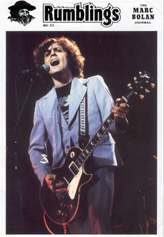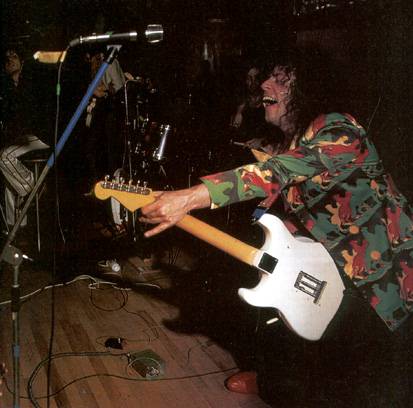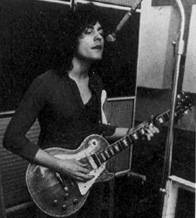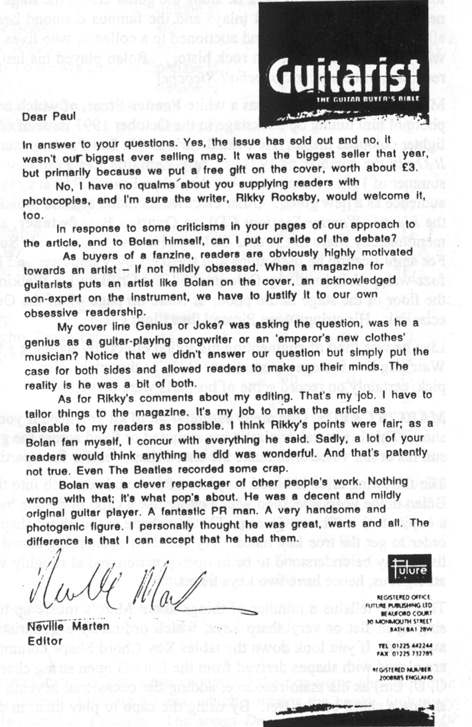 Authors
Note: This material was originally prepared for the Guitarist
article on Bolan in 1997 but for space reasons was omitted. I
have re-written it for Rumblings, added some explanatory material
for the non-musicians amongst its readers.
Authors
Note: This material was originally prepared for the Guitarist
article on Bolan in 1997 but for space reasons was omitted. I
have re-written it for Rumblings, added some explanatory material
for the non-musicians amongst its readers.GUITARS, CAPOS & PROGRESSIONS
by Rikky Rooksby
 Authors
Note: This material was originally prepared for the Guitarist
article on Bolan in 1997 but for space reasons was omitted. I
have re-written it for Rumblings, added some explanatory material
for the non-musicians amongst its readers.
Authors
Note: This material was originally prepared for the Guitarist
article on Bolan in 1997 but for space reasons was omitted. I
have re-written it for Rumblings, added some explanatory material
for the non-musicians amongst its readers.
MARC'S GUITARS
The wild witch wizard of Esher / Was a changeling son from Mars,
He learnt his songs from the cosmic throngs / And played them on a Fender guitar
[from The King of the Mountain Cometh)
On the cover of the T.Rex album (1970) there's a great photo of Bo1an holding the guitar with which he is most associated, a late 50s Gibson Les Paul. The history of this guitar is only marginally less mysterious than that of Excalibur.
Originally a sunburst, 1egend has it that Bolan had it refinished in a unique semi-opaque orange varnish, apparently because the colour reminded him of Eddie Cochran's Gretsh. What's odd is that the Les Paul had a cherry body but a black neck with crown inlays, presumably from a black Les Paul Standard. This is clearly visible in live footage of Bolan playing in Boston, Lincolnshire in January 1972 and in Born To Boogie.
On tour in America later in 1972 he slung the guitar across the stage in a fit of rage and the neck broke, it was replaced by a Les Paul Custom neck with rectangular pearl inlays and the famous diamond headstock pattern. The guitar was eventually stolen from a van in 1977, allegedly resprayed black and auctioned to a collector who lives in France -this is a tragic fate for what was a unique instrument and one with an honourable place in rock history.
Bolan played his last gigs with a new
cherry-red Les Paul. His affection for the Les Paul is recorded,
of course, in Spaceball Ricochet.
Marc's other main guitar was a white Fender Strat, of which he had two, one with a teardrop enamelled sticker. Both can be seen in a photo of him tuning up backstage in the October 1997 issue of Uncut. Note that Bolan favoured rosewood necks on Strats rather than the lighter coloured maple.
He owned various 70s Les Pauls, including a Deluxe and a black Custom, seen on a TOTP performance of Get
it On in the summer of 1971, a Tony Zemaitis Les Paul now owned by Paul McCartney, and a Gibson Flying V bought in the late summer of 1971.
I can remember that when I saw T .Rex at Croydon Fairfields Hall in October 1971 Marc introduced the Flying V to the audience as a new guitar.
Other electrics included a white 3-pickup Gibson SG custom, a sunburst Telecaster (pictured on the sleeve of
the Electric Warrior Sessions CD), an Ovation Breadwinner, and a metal-bodied guitar by U.S. guitar maker John Velino (this may be mentioned by Marc in Chrome Guitar). He also had Antoria Super Nashville 6, Gibson, Epiphone, Aria, Eko and Hayman acoustics.
For amplification he used amps and speakers by Vampower and H/H and Fender combos for practice work. His effects included wall and fuzz-wah pedals (made by Coloursound and CryBaby), a Watkins tape echo and a Rangemaster Treble Booster, the latter can be seen on the floor of the stage in the photo of Marc on page 47 of the October issue of Mojo along with a black on / off switch for the Copycat echo unit. His strings were Picato Ultra Light Guage.
 Live he was fond
of augmenting bis sound effects by scraping a tambourine against
the strings of bis Strat during the extended Get it On.
Live he was fond
of augmenting bis sound effects by scraping a tambourine against
the strings of bis Strat during the extended Get it On.
Watching live footage it sometimes looks as though he dispensed with a pick and played with his first finger, using the nail as a substitute pick, certainly on record some of his parts were played with his fingers.
MARC'S CAPOS One pretty essential bit of kit you need if you want to play most of Marc's early songs is a capodastra, or 'capo' for short. This is a metal or plastic bar strapped or fixed across the guitar neck which enables the performer to change the key of a song to suit his or her voice or to make the chord shapes easier for a particular key.
The following table is based on years of persona! research into the way Marc played these songs. It lists all the songs released by Marc Bolan in the years specified which either use a capo or detune by a semi-tone. The only number I haven't checked (because I don't have a copy of it) is Demon Queen. The key shape is the chord shape you would use with the capo in position or with the guitar detuned in order to get the true key listed. Try standard open string chord shapes to work out the rest of the song in that position. Any song not listed may be understood to be in open position and at roughly standard pitch. Some songs listed either change key or are harmonically ambiguous, hence have two keys listed.
This table tells us a number of things about Marc's music up to 1972. He had a fondness for the sound of the capoed guitar and for singing in flat or very sharp keys, which ordinarily a guitarist would avoid unless using a capo because the chord shapes would be awkward. Ifyou look down the tables Key Chord Shape column you will notice that whatever the key, the vast proportion of the songs are played with shapes derived from the Em / G open string chords. This indicates that Marc used a handful of easy chord shapes (G, A,C, D, Em) as his main resource, adding the occasiona! seventh and one or two exotic variants here and there by lifting a finger off or
sliding a chord back a fret. By using the capo to play them in different places on the neck, he made them sound a bit different to each other .
I have not investigated his possible use of the capo after The Slider, though I know that Electric Slim uses a capo at IV to play in E major.
Fiddling with capos live is something guitarists don't like doing, the capo can put the guitar slightly out of tune and moving it usually requires a check of the tuning. In the laid-back context of a folk club this might not matter, but it's not hard to see that in the heat and flow of a rock concert that this might be a nuisance. I believe this is one reason Marc made less use of the capo once he 'went electric'.
Incidentally, if you refer to page 49 of the aforementioned issue of Mojo, you 'll see a b/w photo of Marc singing into a mike with a Les Paul, Mojo 's note tells us this is a BBC session, if you look carefully you can see a capo at the 4th fret -which means Marc is playing Ride A White Swan!

MARC'S FORMULA In an interview Bolan once claimed he had found a formula for hit records. He
told Disc and Music Echo (November 1970), 'I've suddenly tuned into that mental channel which
makes a record a hit, and I feel at present as though I could write Number ones for ever. Let's face it, the
majority of pop hits that make it are a permutation on the twelve-bar blues and I've found one that works. ' Although Bolan never said what it was, it is possible to deduce this permutation from his I songwriting, which is built on a few basic ideas:
[For those unfamiliar with music theory: each key has 7 primary chords, numbered by roman numerals. In a major key, I IV and VI are always minor, and VII is a diminished. In pop music the VII is often flattened and turned into a major chord].
> The I-VI or IV-II change in any major key.
In G this would be G to Em and C to Am.
Think of Metal Guru and Hot Love. These
chords often are linked with a passing note
G F -E or C B A. This is the 'three note'
motif which Mark Paytress refers to in his book.
> The C-Am-F-G sequence so typical of late
50s doo-wop and early 60s teen bailads as
in Runaround Sue or Teenager in Love.
Bolan used this on Cat Black, Dandy In The
Underworld and many others. On the
Electric Warrior Sessions disc Marc can be
heard jokingly introducing Monolith as
' Duke of Earl... or Duke of Monolith.'
> 12-bar sequences in E and A.
> 6 bar phrases using chords I and IV .
Telegram Sam 's verse pattern is
A.../ /D.../A.../ / /. Get It On goes
E.../A.../E.../A.../E.../...
> The I-bIII change, E-G, as in Children of
the Revolution.
One of his favourite ploys was to juxtapose a 12 or 6 pattern with C-Am-F-G or a similar pop variation.
This features in songs like Is It Love?, Jewel, The Motivator, Telegram Sam, Rabbit Fighter, Children
of the Revolution, Solid Gold Easy Action and Teenage Dream. Teenage Dream was hyped by Bolan as something incredibly new, a re-invention of T .Rex, when in fact it was the C-Am-F-G chord
sequence of Cat Black with an added E but decked out with a heavily layered arrangement. This
indicated that there was little growth in the underlying structure of his music, all he did was
present the same basic ideas in different arrangements. Part of my (now infamous) lack of enthusiasm for the later T .Rex is that often Marc was merely creating pastiches of whatever style he claimed he was into that year (i.e. soul!). The underlying music is the same; only the arrangements change, and often the musical ideas are not strong enough to take the weight. He lacked the music sophistication to be Marvin Gaye or Bessie Smith or
Holland-Dozier-Holland. The tragedy of this is that he stopped doing the thing he was best at -i.e.
writing the electric boogie songs that only Marc Bolan could write.
Many of the Tyrannosaurus Rex songs do not use the pop-verse-chorus-middle eight structure, instead repeating a verse which contains the hook. Only very rarely did Bolan use key changes. The songs Dragon 's Ear from Beard Of Stars is a notable exception, with sections that contrast by key and tempo, and Sunken Rags and The Time Of Love Is Now have some interesting chord changes in them. It is not uncommon to find him contrasting E major with G major as in Children of the Revolution and Elemental Child. One of the things that makes Raw Ramp satisfying is that section 1 (There Was A Time) is in C / Em, section 2 (Raw Ramp) is in G, and section 3 (Electric Boogie) is in E. This is a nice contrast of keys.
Rikky Rooksby @ 1998
Table of Capo positions and tunings , Beat Instrumental article , Back to main site ( Write Me a Song )